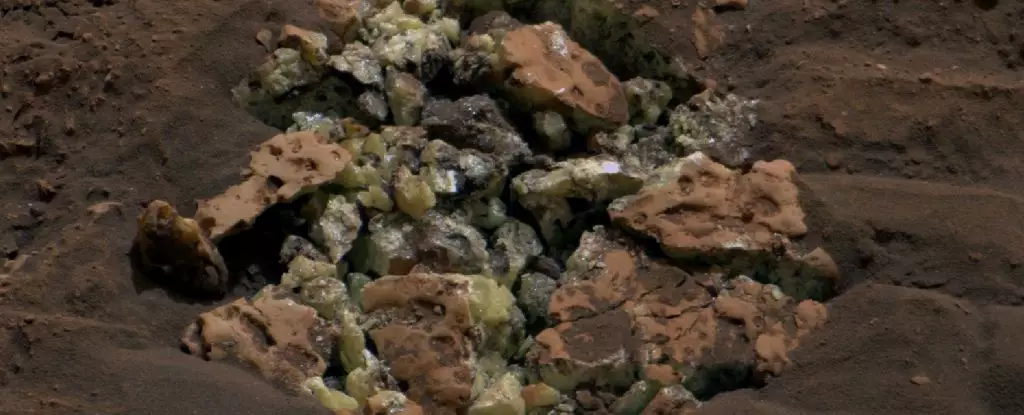In a remarkable incident, NASA’s Curiosity rover stumbled upon a rare geological phenomenon on Mars. While traversing the Martian landscape, Curiosity cracked open an otherwise unremarkable rock, unveiling a striking treasure: vibrant yellow crystals of pure elemental sulfur. This intriguing finding, which occurred in May during its exploration of the Gediz Vallis Channel, marks the first time that sulfur has been identified in its elemental form on the Martian surface. While sulfates—sulfur mixing with other minerals in water—are relatively common on Mars, the existence of pure sulfur raises tantalizing questions about the planet’s geological and possibly biological history.
The significance of this discovery extends beyond the mere presence of sulfur. The Gediz Vallis Channel itself is characterized by a landscape dotted with rocks that bear a striking resemblance to the sulfur rock prior to its accidental breaching. This resemblance suggests that there may be a broader abundance of elemental sulfur hidden within this region. Ashwin Vasavada, the project scientist for Curiosity, aptly described the potential of discovering a “field of stones made of pure sulfur” as akin to finding “an oasis in the desert.” This statement highlights the extraordinary nature of such a find in a place where conditions for the formation of pure sulfur are not clearly understood, thus provoking a deeper inquiry into Mars’ geological narrative.
Sulfates, known to be salts resulting from the combination of sulfur with other minerals in aqueous environments, provide crucial insights into Mars’ watery past. The evaporation of water leads to the precipitation of sulfates, which in turn serves as a geological record of Mars’ climatic evolution. Conversely, pure sulfur is formed under very specific conditions, which have not been previously identified in the surrounding area of Curiosity’s discovery. The existence of pure sulfur rocks implies that either a new geological process was at play, or that environmental conditions conducive to pure sulfur formation might have occurred in the ancient history of Mars. Thus, the intrinsic geological puzzle presented by this occurrence has far-ranging implications for our understanding of Mars’ past.
While the presence of pure sulfur may not directly herald the discovery of extraterrestrial life, it underscores the essential role of sulfur in biological systems on Earth. Sulfur is a component of vital amino acids that form proteins, which are fundamental building blocks of life. The continued discovery of substances—such as sulfur and previously known sulfates—on the Martian landscape hints at an environment that once harbored the necessary elements for life. Scientists remain hopeful, as piecing together Mars’ geological history may unlock insights into whether conditions could have once been suitable for life.
Given the inherent limitations of remotely studying Mars from Earth, the work of the Curiosity rover is crucial. The rover’s onboard instruments have been instrumental in identifying the sulfurous composition of rocks and determining the implications of such findings. The accidental cracking of the sulfur rock speaks to the serendipitous nature of scientific exploration; had Curiosity taken a different route, this discovery might have eluded researchers for an extended period. Moving forward, the scientific community’s next steps will involve a series of analyses and models that aim to explain the origins and implications of the sulfur deposits on Mars.
As Curiosity continues its mission across the ancient beds of the Gediz Vallis Channel—once lined with waters billions of years ago—it serves not only as a robotic explorer but as a key to deciphering the ancient environmental conditions of Mars. With each rock it examines and every sample it analyzes, it brings us closer to unraveling the intricate story of the Red Planet, opening the door to both understanding its geological history and contemplating the age-old question of life beyond Earth. The journey of discovery is far from over, and the excitement of what may lie ahead remains palpable.


Leave a Reply